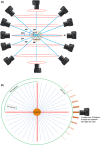A workflow for the creation of photorealistic 3D cadaveric models using photogrammetry
- PMID: 37432760
- PMCID: PMC10335382
- DOI: 10.1111/joa.13872
A workflow for the creation of photorealistic 3D cadaveric models using photogrammetry
Abstract
Three-dimensional (3D) representations of anatomical specimens are increasingly used as learning resources. Photogrammetry is a well-established technique that can be used to generate 3D models and has only been recently applied to produce visualisations of cadaveric specimens. This study has developed a semi-standardised photogrammetry workflow to produce photorealistic models of human specimens. Eight specimens, each with unique anatomical characteristics, were successfully digitised into interactive 3D models using the described workflow and the strengths and limitations of the technique are described. Various tissue types were reconstructed with apparent preservation of geometry and texture which visually resembled the original specimen. Using this workflow, an institution could digitise their existing cadaveric resources, facilitating the delivery of novel educational experiences.
Keywords: 3D visualisation; anatomy visualisation; cadaver; photogrammetry.
© 2023 The Authors. Journal of Anatomy published by John Wiley & Sons Ltd on behalf of Anatomical Society.
Figures









References
-
- Apollonio, F.I. , Fantini, F. , Garagnani, S. & Gaiani, M. (2021) A photogrammetry‐based workflow for the accurate 3D construction and visualization of museums assets. Remote Sensing, 13, 486.
-
- Aziz, M.A. , Mckenzie, J.C. , Wilson, J.S. , Cowie, R.J. , Ayeni, S.A. & Dunn, B.K. (2002) The human cadaver in the age of biomedical informatics. The Anatomical Record: An Official Publication of the American Association of Anatomists, 269, 20–32. - PubMed
-
- Benjamin, A. , O'brien, D. , Barnes, G. , Wilkinson, B. & Volkmann, W. (2017) Assessment of structure from motion (SfM) processing parameters on processing time, spatial accuracy, and geometric quality of unmanned aerial system derived mapping products. Journal of Unmanned Aerial Systems, 3, 27.
-
- Bergman, E. , van der Vleuten, C.P. & Scherpbier, A.J. (2011) Why don't they know enough about anatomy? A narrative review. Medical Teacher, 33, 403–409. - PubMed
Publication types
MeSH terms
LinkOut - more resources
Full Text Sources

